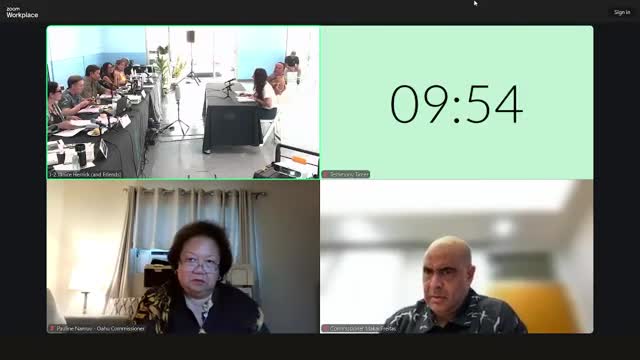Kahikinui community and restoration groups outline fence, fog-drip and reforestation progress
October 22, 2025 | Hawaiian Home Lands (DHHL), Department of, Executive , Hawaii
This article was created by AI summarizing key points discussed. AI makes mistakes, so for full details and context, please refer to the video of the full meeting. Please report any errors so we can fix them. Report an error »

Community leaders and conservation partners gave commissioners a multi-part update on Leeward Haleakalā (Kahikinui) restoration efforts, highlighting completed perimeter fencing, piloted fog-drip (cloud-harvesting) systems, seed-source plots and next steps for reservoir, fencing and animal-removal work.
Why it matters: Kahikinui contains large portions of Maui’s remaining native dry forest and is a core watershed area. Testimony tied forest restoration to water capture, wildfire risk reduction and cultural-resource protection.
What speakers said: Andrea Buckman, executive director of Uhiwai'o Haleakala, said the partnership work has helped fence roughly 4,500 acres and that the perimeter fence completed by partners totals about 9.3 miles; current active management is focused on a 117‑acre unit where complete animal removal is possible. Buckman described seed-source test plots and noted that restoration efforts across partnerships represent more than $44 million in public and private money invested to date.
Keʻāina leaders described local fog-drip and cloud-harvesting projects. Kaohano o Kahikinui president (testimony delivered by a community presenter) said a fog‑drip pilot produced data showing up to about 2,000 gallons a day at collection points and that a planned overland pipeline would bring captured water to a community center; the community seeks right-of-entry and expanded license terms for the fog-drip capture site and pipeline. The group also seeks support for reservoir restoration, fire-mitigation corridors (approximately 300 feet wide) and local road upgrades to permit access for planting and emergency response.
Concerns and constraints: Speakers emphasized repeated fence vandalism, animal incursions and the need for sustained funding for fence inspection and repairs. They also asked DHHL to consider delegating certain road‑improvement funds directly to community nonprofit grantees to speed construction, citing a long-standing internal maintenance fund they said could be reallocated for local projects.
Department and commission reaction: Commissioners thanked presenters and said DHHL would review funding and program options; no formal decision or vote occurred during the meeting.
Ending: Community groups requested beneficiary consultation, additional operational funding and continued partnership with DHHL, state agencies and federal funders to scale fencing repairs, reservoir upgrades and fog-drip installations.
Why it matters: Kahikinui contains large portions of Maui’s remaining native dry forest and is a core watershed area. Testimony tied forest restoration to water capture, wildfire risk reduction and cultural-resource protection.
What speakers said: Andrea Buckman, executive director of Uhiwai'o Haleakala, said the partnership work has helped fence roughly 4,500 acres and that the perimeter fence completed by partners totals about 9.3 miles; current active management is focused on a 117‑acre unit where complete animal removal is possible. Buckman described seed-source test plots and noted that restoration efforts across partnerships represent more than $44 million in public and private money invested to date.
Keʻāina leaders described local fog-drip and cloud-harvesting projects. Kaohano o Kahikinui president (testimony delivered by a community presenter) said a fog‑drip pilot produced data showing up to about 2,000 gallons a day at collection points and that a planned overland pipeline would bring captured water to a community center; the community seeks right-of-entry and expanded license terms for the fog-drip capture site and pipeline. The group also seeks support for reservoir restoration, fire-mitigation corridors (approximately 300 feet wide) and local road upgrades to permit access for planting and emergency response.
Concerns and constraints: Speakers emphasized repeated fence vandalism, animal incursions and the need for sustained funding for fence inspection and repairs. They also asked DHHL to consider delegating certain road‑improvement funds directly to community nonprofit grantees to speed construction, citing a long-standing internal maintenance fund they said could be reallocated for local projects.
Department and commission reaction: Commissioners thanked presenters and said DHHL would review funding and program options; no formal decision or vote occurred during the meeting.
Ending: Community groups requested beneficiary consultation, additional operational funding and continued partnership with DHHL, state agencies and federal funders to scale fencing repairs, reservoir upgrades and fog-drip installations.
View the Full Meeting & All Its Details
This article offers just a summary. Unlock complete video, transcripts, and insights as a Founder Member.
✓
Watch full, unedited meeting videos
✓
Search every word spoken in unlimited transcripts
✓
AI summaries & real-time alerts (all government levels)
✓
Permanent access to expanding government content
30-day money-back guarantee

